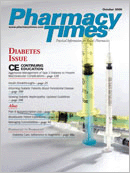Publication
Article
Pharmacy Times
ASTHMA WATCH
Asthma Higher Among Special Education Students
A new study has shed light on theprevalence of asthma in special educationstudents. Statistics indicated that 1 in 3special education students in New YorkCity public schools have asthma, comparedwith 1 in 5 students in the generalpopulation, according to a study reportedin the American Journal of Public Health(September 2006).
To investigate a possible correlationbetween having the condition and beingin special education, the researchers surveyed24 randomly selected New YorkCity public schools using parent questionnaires.The responses showed that 34% ofstudents in special education classes hadasthma, compared with 19% of studentsin the general school population. Theinvestigators calculated that children withasthma faced a 60% increased risk ofbeing in special education, comparedwith children without asthma.
The findings also indicated that childrenwith asthma who were in special educationwere more prone to be from low-incomefamilies and 3 times more apt tobe hospitalized for asthma in the pastyear. Furthermore, this population was50% less likely to use a peak flow meterand 15% less likely to use a spacer.
Asthma Care Differs AmongEthnic Groups
Racial disparity appears to play a role in the asthma care of PuertoRican children and African American children, and the reasons for thedifference are unclear. The study looked at the data from >6500 childrenfrom inner-city Hartford, Conn, who were screened for the condition.
The researchers found that Puerto Rican children with asthma make30% more outpatient clinic visits, compared with black children with thesame disease severity. On the flip side, black children spend 3 timesmore days in the hospital for asthma treatment, compared with PuertoRican children. Furthermore, the study showed that, overall, 18% of childrenwith unrelenting asthma filled prescriptions for preventive medications.Puerto Rican families were more likely to fill those prescriptionsthan black families.
Lead investigator Robyn Cohen, MD, said more research is needed todetermine why the differences exist. "The Puerto Rican children hadgreater asthma severity, so it was interesting that the African Americanchildren ended up spending more days in the hospital," she said. "Is thatbecause Puerto Rican children get more care early in their lives? Are wenot reaching out enough to make all families feel comfortable coming tothe clinic? Are we not teaching families to recognize symptoms? Wedon't know." (The findings were reported in Chest, August 2006.)
Research SupportsDual Therapy
A Swedish study backed the use of combined asthmatherapy using inhaled corticosteroids and antileukotrienefor patients with persistent asthma. Thestudy of 13 patients looked at whether the inhaled corticosteroidtreatment fluticasone propionate reducedbronchial responsiveness to leukotriene D4.
The patients participated in an inhalation challengewith methacholine and leukotriene D4 onconsecutive days, before and after 2 weeks oftwice-daily treatment with fluticasone. The fluticasonetherapy showed a dramatic reduction inmethacholine sensitivity—a measure of airwayhyperresponsiveness—and in exhaled nitric oxide.
Reporting in the Journal of Allergy and ClinicalImmunology (July 2006), the researchers found, however,that the fluticasone treatment did not have anyeffect in preventing the bronchoconstriction that happenedwhen leukotrienes were inhaled by the patients.The treatment also did not impact the production ofleukotrienes, as measured in the patients' urine.
Pediatric Asthma Care Gets Boost
The National Association of Chain Drug Stores Foundationrecently awarded a $100,000 research grant potentially totaling$300,000 over 3 years to the Children's National MedicalCenter (CNMC) in Washington, DC. The grant supports communitypharmacists' intervention in "Improving PediatricAsthma Care in the District of Columbia" (IMPACT DC).
The CNMC and community pharmacy will develop andexecute a model program of "enhanced pharmacy care." Itwill allow patients and families in disadvantaged minorityareas of Washington, DC, to be referred to specifically trainedpharmacists in participating pharmacies. The goal of the initiativeis to improve medical and functional outcomes inpatients with asthma 12 months to 12 years old in underservedareas of the Washington, DC, region.
The CNMC Asthma Clinic will create the training program forparticipating community pharmacies (Rite Aid and CVS) selectedby CNMC. The pharmacists will receive prescriptions forpatients with asthma directly from the clinic and will providethem with asthma drugs, devices, and education. In addition,pharmacists will provide patients and their families with realtime,targeted education around the purpose and use of newand refilled asthma medication. The education will includedevice teaching, dosage review, and medication compliance.
Staff from IMPACT DC will assess the success of theprogram through participant and pharmacist reports, collectingrefill data from each pharmacy monthly, and conductingfollow-up interviews with participants at 1, 3, and6 months after their clinic visit.







